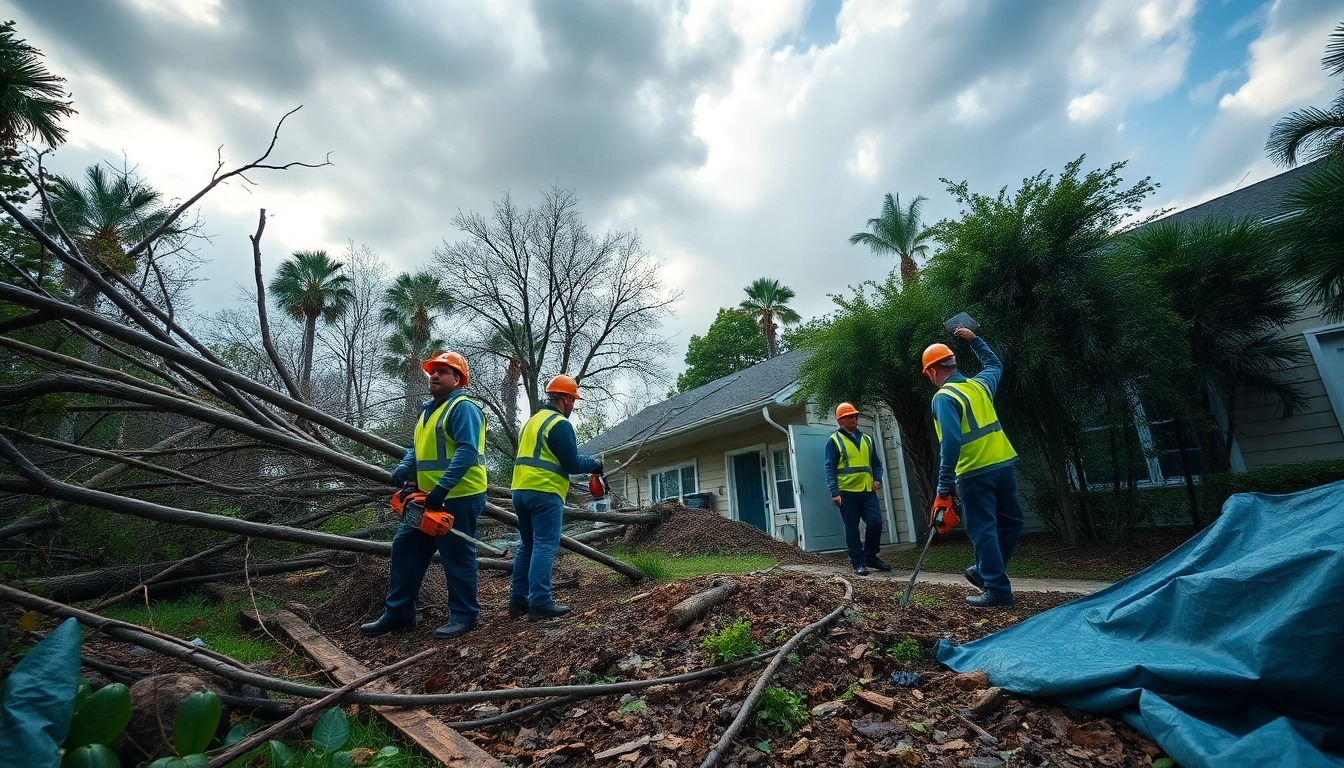Understanding Storm Damage: Types and Impact
Common Types of Storm Damage
Storms can wreak havoc on properties, causing various types of damage that can range from minor to catastrophic. The primary types of storm damage include:
- Wind Damage: High winds can tear off roofs, shatter windows, and uproot trees, leading to severe structural damage.
- Flooding: Heavy rains can lead to flash flooding and groundwater infiltration, causing water damage to homes and businesses.
- Hail Damage: Hail storms can create dents and breaks in roofing materials, siding, and vehicles, necessitating repairs or replacements.
- Lightning Strikes: Lightning can cause fire damage or electrical surges that may destroy appliances or spark larger fires.
- Debris Damage: Flying debris from storms can break windows and damage siding or roofs, resulting in additional repair needs.
How Storms Affect Your Property
The effects of storm damage can be extensive, impacting both the physical structure and the overall value of a property. Heavy rainfall can lead to water pooling around foundations, potentially causing long-term structural issues. Wind can strip away protective layers, increasing vulnerability to future storms. Understanding the impact of storms on properties is essential for effective restoration and mitigation efforts.
Signs of Severe Damage
Recognizing the signs of severe damage after a storm is crucial for timely restoration. Homeowners should look for:
- Visible roof damage, such as missing shingles or tiles.
- Water stains on ceilings or walls, indicating potential leaks.
- Broken windows or doors that compromise security.
- Wet or damaged carpets and flooring that may harbor mold.
- Uprooted trees or significant debris around the property.
Preparation for Storm Damage Restoration and Cleanup
Creating an Emergency Plan
Preparation is critical for minimizing damage and ensuring safety during storm events. An effective emergency plan should include:
- Evacuation routes and designated safe locations.
- A communication strategy for connecting with family members.
- Contact information for local emergency services and restoration companies.
Essential Tools and Supplies
Having the right tools and supplies ready can facilitate an effective response to storm damage. Key items include:
- A first aid kit to address minor injuries.
- Tarps and plastic sheeting for temporary waterproofing.
- Pumps and wet/dry vacuums for water removal.
- Basic hand tools for debris removal and minor repairs.
Safety Precautions to Consider
Safety should always come first during storm recovery efforts. Important precautions include:
- Wearing protective gear, such as gloves and masks.
- Ensuring electrical systems are safe before entering flooded areas.
- Being aware of potential hazards, such as broken glass and unstable structures.
Step-by-Step Process of Storm Damage Restoration and Cleanup
Initial Assessment and Documentation
The first step in the storm damage restoration process is conducting a thorough assessment. This should involve:
- Documenting all visible damage with photographs and notes for insurance claims.
- Creating a comprehensive list of affected areas and items.
- Assessing the structural integrity of the home or building.
Water Removal Techniques
Water damage can lead to serious issues, such as mold growth. Effective water removal techniques include:
- Using submersible pumps for standing water in basements or crawl spaces.
- Employing industrial-grade vacuums to extract moisture from carpets and padding.
- Utilizing dehumidifiers and fans to accelerate the drying process.
Debris Removal and Cleanup
Following water removal, the next step is clearing out debris. This involves:
- Safely removing fallen branches and uprooted plants.
- Clearing out damaged furniture and personal belongings that are beyond repair.
- Disposing of hazardous materials responsibly, such as chemicals or electrical items.
Restoration Techniques for Different Types of Damage
Dealing with Water Damage
Water damage restoration requires specific techniques to ensure complete recovery and prevent mold growth:
- Replacement of water-damaged drywall and insulation.
- Cleaning and sanitizing affected areas with appropriate solutions.
- Assessing and repairing electrical systems that may have been affected by water.
Addressing Structural Damage
Structural damage must be evaluated and repaired to maintain safety. This includes:
- Inspecting load-bearing walls and beams for compromise.
- Utilizing professional services for significant structural repairs.
- Reinforcing or rebuilding damaged areas to meet building codes.
Repairing Exterior Damage
The exterior of the property often bears the brunt of storm damage. Restoration tasks include:
- Replacing damaged roofing materials and ensuring proper waterproofing.
- Inspecting and repairing siding to protect against further weather exposure.
- Rebuilding or reinforcing decks, patios, and other structures.
Post-Restoration Best Practices and Maintenance
Evaluating the Restoration Work
After restoration, it’s essential to evaluate the quality of the repairs. Consider:
- Having a professional inspection to verify workmanship and safety.
- Documenting completed work for future reference and insurance.
Preventive Measures for Future Storms
Implementing preventive measures can significantly reduce the risk of future storm damage. Key strategies include:
- Regular maintenance checks on roofs, gutters, and drainage systems.
- Investing in protective landscaping that mitigates erosion and flooding.
- Installing storm shutters and reinforcing doors and windows.
Long-term Maintenance Tips
Maintaining the integrity of your property post-restoration is vital. Tips for long-term care include:
- Conducting seasonal inspections to identify and address wear.
- Keeping records of maintenance and repairs to track improvement over time.
- Educating family members or employees about storm preparedness and safety measures.
In summary, understanding and effectively managing Storm Damage Restoration and cleanup is critical for protecting property and ensuring safety in storm-prone areas. By preparing adequately, following step-by-step restoration techniques, and implementing post-restoration best practices, homeowners can significantly mitigate the impact of future storms.
